Teaching Methods, Learning and Development: A 15-Year Research Perspective by Educational Stages
Abstract
1. Introduction
2. Methodology
2.1. Search Strategy and Datasets
2.2. Data Preparation
2.3. Data Analysis Procedure
2.4. Interpretation of Results
3. Results
3.1. Temporal Description of Teaching Methods in the Learning and Perception Knowledge Area in Elementary, Secondary, and Post-Secondary Educational Stages
3.2. Change in the Use and Study of Terms Related to Learning and Perception Across the Three Educational Stages


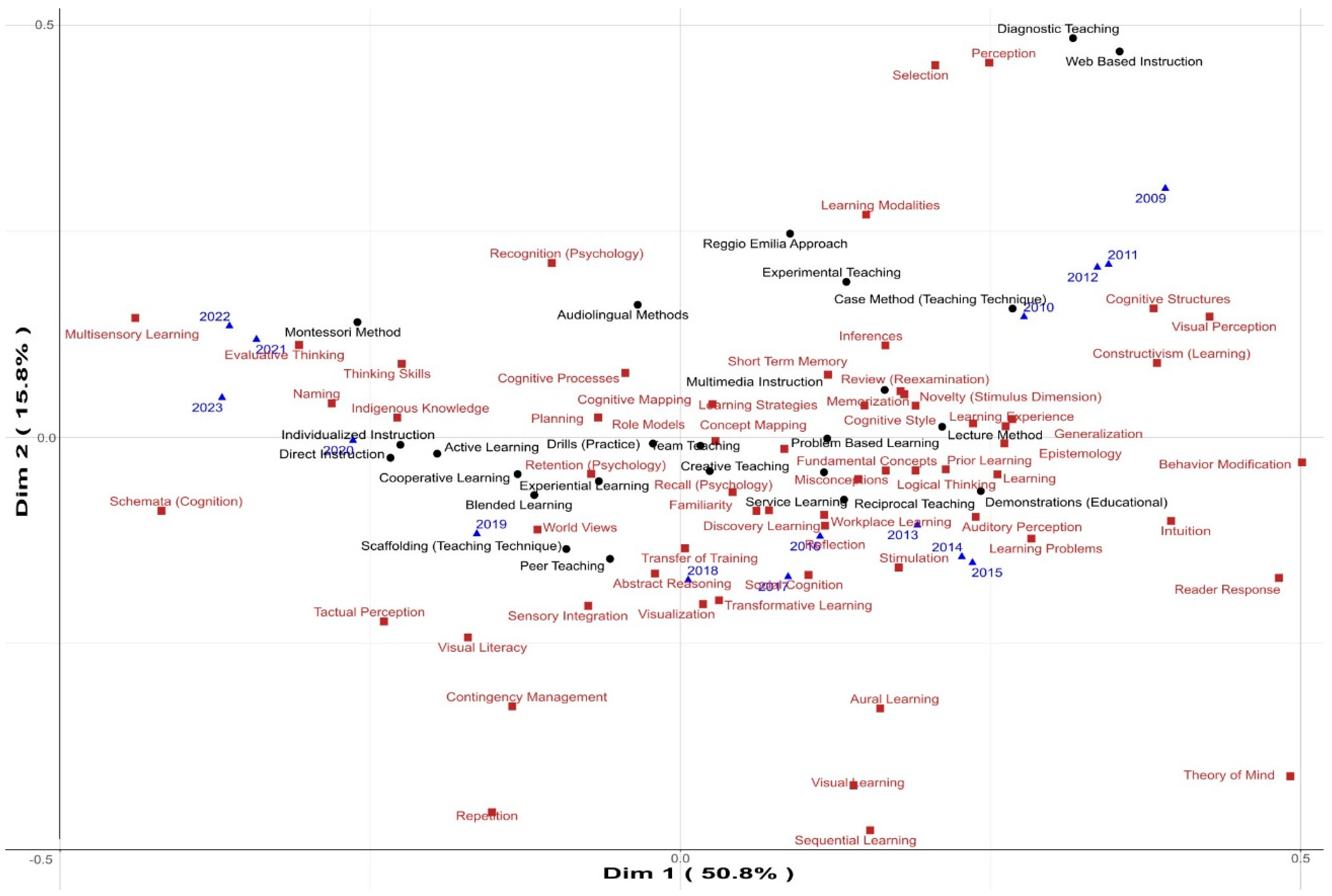
3.3. Temporal Description of Teaching Methods in the Individual Development and Characteristics Knowledge Area in Elementary, Secondary, and Post-Secondary Stages
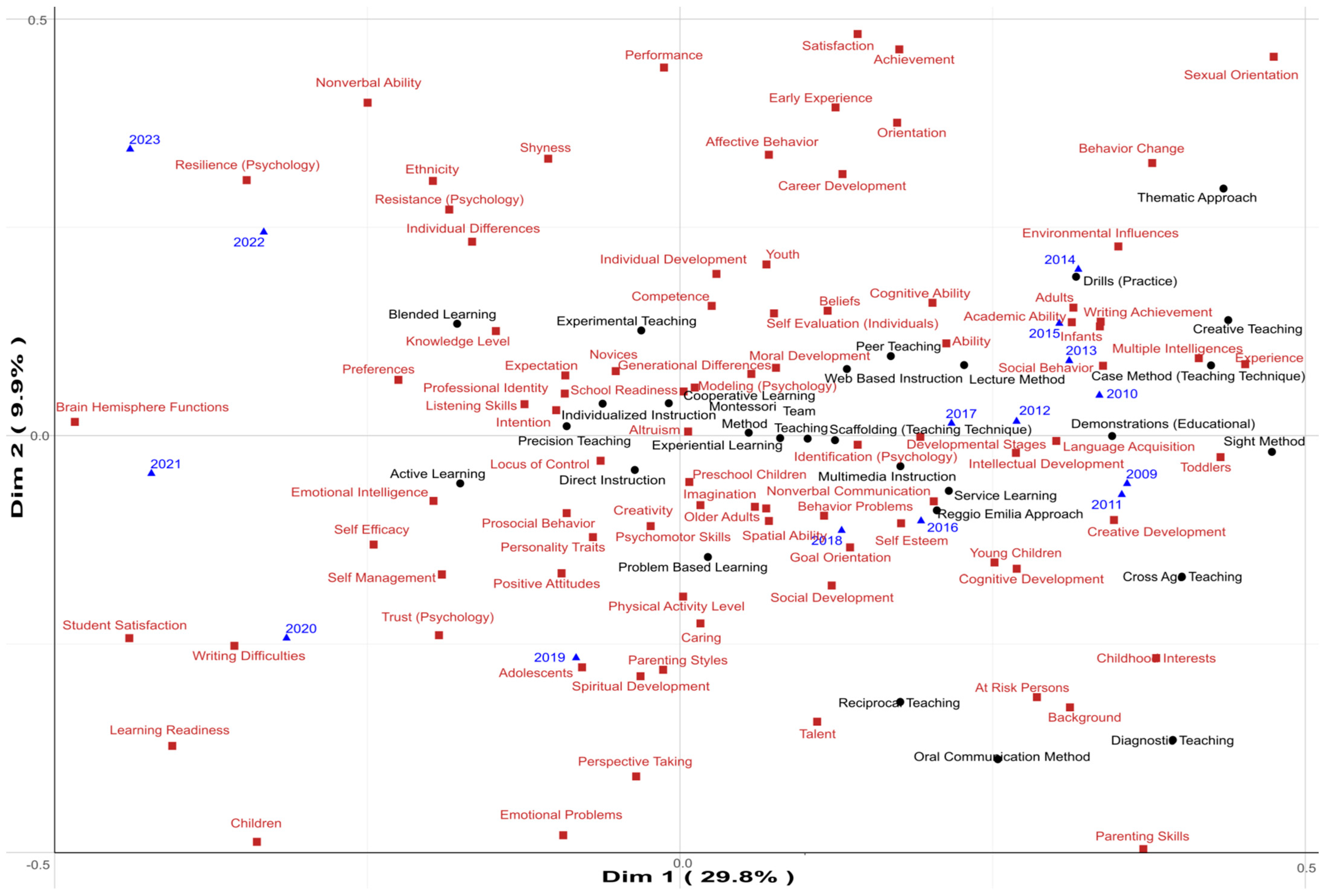
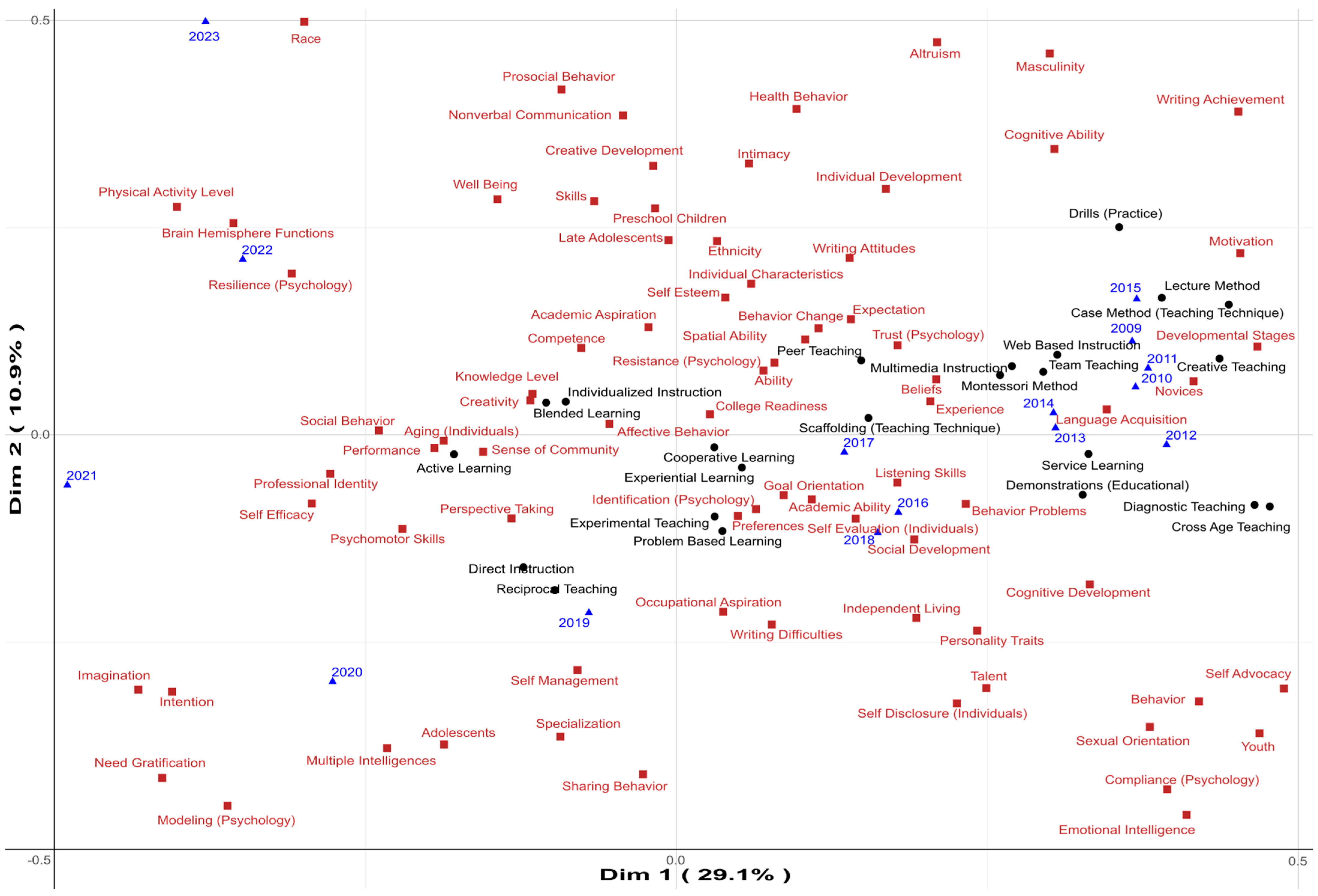
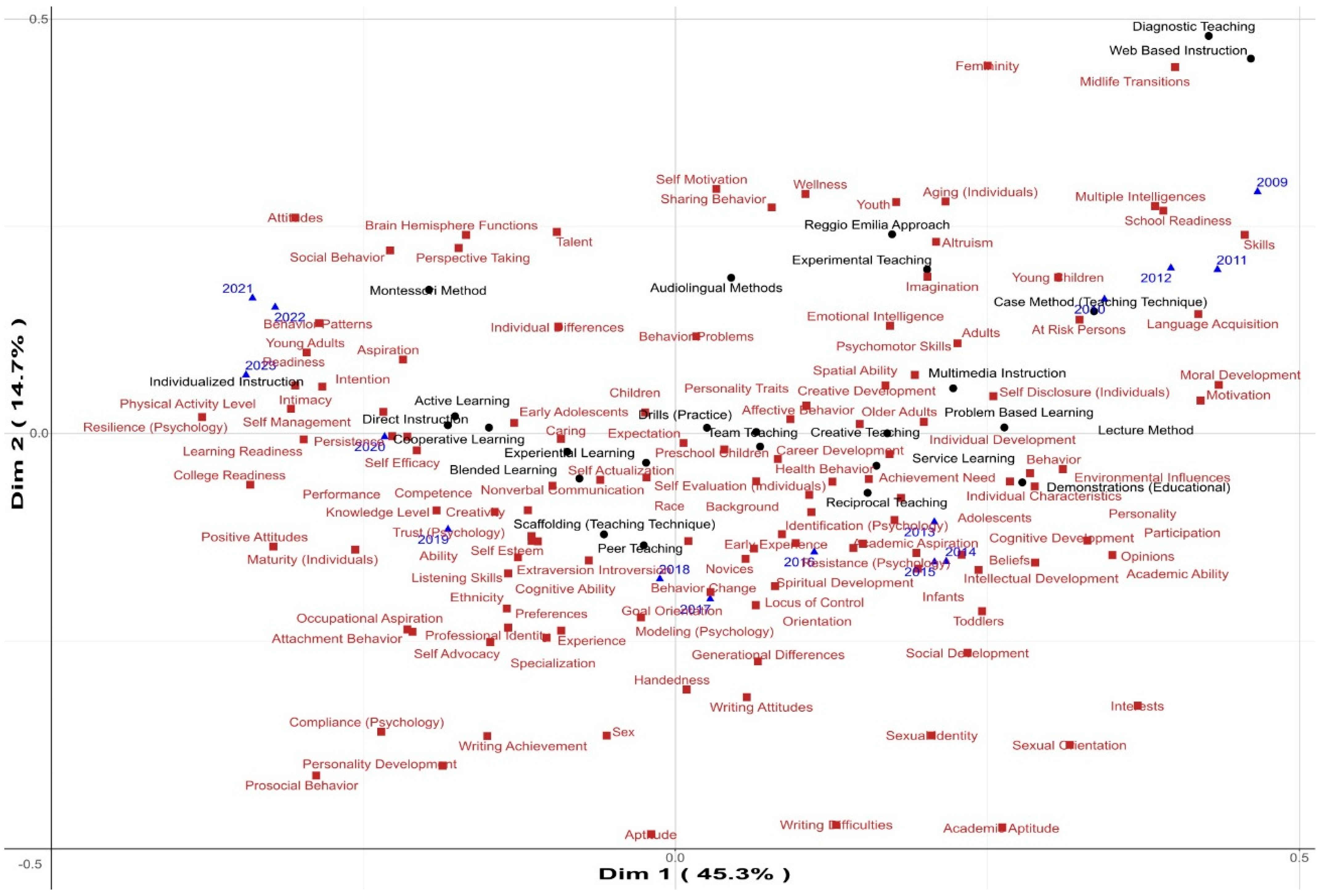
3.4. Change in the Use and Study of Terms Related to Individual Development and Characteristics Across the Three Educational Stages
4. Discussion
5. Conclusions
Supplementary Materials
Author Contributions
Funding
Institutional Review Board Statement
Informed Consent Statement
Data Availability Statement
Acknowledgments
Conflicts of Interest
References
- Al-Haddad, S. S., Afari, E., Khine, M. S., & Eksail, F. A. A. (2023). Self-regulation, self-confidence, and academic achievement on assessment conceptions: An investigation study of pre-service teachers. Journal of Applied Research in Higher Education, 15(3), 813–826. [Google Scholar] [CrossRef]
- Baepler, P., Walker, J. D., Brooks, D. C., Saichaie, K., & Petersen, C. I. (2016). A guide to teaching in the active learning classroom: History, research, and practice. Stylus; Routledge. [Google Scholar]
- Barboyon Combey, L., & Gargallo López, B. (2022). Métodos centrados en el estudiante. Sus efectos en las estrategias y los enfoques de aprendizaje de los universitarios [Student-centred methods. Their effects on university students’ learning strategies and approaches]. Teoría de la Educación. Revista Interuniversitaria, 34(1), 215–237. [Google Scholar] [CrossRef]
- Barr, R. B., & Tagg, J. (1995). From teaching to learning. A new paradigm for undergraduate education. Change, 27(6), 13–25. [Google Scholar] [CrossRef]
- Bhutoria, A. (2022). Personalized education and Artificial Intelligence in the United States, China, and India: A systematic review using a Human-In-The-Loop model. Computers and Education: Artificial Intelligence, 3, 100068. [Google Scholar] [CrossRef]
- Biggs, J. (1996). Enhancing teaching through constructive alignment. Higher Education, 32(3), 347–364. [Google Scholar] [CrossRef]
- Brabrand, C. (2008). Constructive alignment for teaching model-based design for concurrency. In Transactions on petri nets and other models of concurrency I (pp. 1–18). Springer. [Google Scholar] [CrossRef]
- Bransford, J., Brophy, S., & Williams, S. (2000). When computer technologies meet the learning sciences: Issues and opportunities. Journal of Applied Developmental Psychology, 21(1), 59–84. [Google Scholar] [CrossRef]
- Butt, S., Mahmood, A., Saleem, S., Murtaza, S. A., Hassan, S., & Molnár, E. (2023). The contribution of learner characteristics and perceived learning to students’ satisfaction and academic performance during COVID-19. Sustainability, 15(2), 1348. [Google Scholar] [CrossRef]
- Corujo-Vélez, C., Gallego, M. R. R., & Hervás-Gómez, C. (2019). Necesidades formativas en competencia digital y valores en la educación de maestros y pedagogos en formación inicial [Training needs in digital competence and values in the education of teachers and educators in initial training]. In Innovación e investigación sobre el aprendizaje ubicuo y móvil en la educación superior (pp. 113–137). Octaedro. [Google Scholar]
- Crisol-Moya, E., Romero-López, M. A., & Caurcel-Cara, M. J. (2020). Active methodologies in higher education: Perception and opinion as evaluated by professors and their students in the teaching-learning process. Frontiers in Psychology, 11, 1703. [Google Scholar] [CrossRef]
- De las Heras Fernández, R., & Espada, M. (2020). Estrategias y Estilos de Enseñanza en la Clase Magistral de estudios oficiales de Danza Española y Flamenco [Teaching strategies and styles in the master class of official Spanish dance and Flamenco studies]. Retos: Nuevas Tendencias en Educación Física, Deporte y Recreación, 38, 671–678. [Google Scholar] [CrossRef]
- De Miguel Diaz, F. M. (Coordinator). (2006). Metodologías de enseñanzas y aprendizaje para el desarrollo de competencias: Orientaciones para el profesorado universitario ante el espacio europeo de educación superior [Teaching and learning methodologies for skills development: Guidance for university lecturers in the European higher education area]. Alianza. [Google Scholar]
- DeSeCo Project. (2005). The definition and selection of key competencies. Executive summary. Organisation for Economic Co-operation and Development. Available online: http://www.oecd.org/pisa/definition-selection-key-competencies-summary.pdf (accessed on 27 February 2024).
- Eccles, J. S., & Roeser, R. W. (2011). Schools as developmental contexts during adolescence. Journal of Research on Adolescence, 21(1), 225–241. [Google Scholar] [CrossRef]
- Erciyes, E. (2020). Reflections of a social constructivist on teaching methods. European Journal of Educational Sciences, 7(4), 16–24. [Google Scholar] [CrossRef]
- Feixas, M., & Zellweger, F. (2020). Teaching awards with impact: Beyond the recognition of excellence. REDU. Revista de Docencia Universitaria, 18(1), 193–209. [Google Scholar] [CrossRef]
- Fernández Fernández, I., & Madinabeitia Ezkurra, A. (2020). La transformación docente de la universidad a 20 años de Bolonia: Balance y claves para un futuro por definir [The transformation of university teaching 20 years after Bologna: Assessment and keys to a future yet to be defined]. Revista de Currículum y Formación del Profesorado, 24(2), 28–52. [Google Scholar] [CrossRef]
- Ferrara, L., & Flammia, A. (2018). Active Didactic methodologies in the high school as effective education strategies to animate students’ participation. Journal of Humanities and Social Science, 23(5), 40–47. [Google Scholar] [CrossRef]
- Fortea Bagán, M. Á. (2019). Metodologías didácticas para la enseñanza/aprendizaje de competencias [Teaching methodologies for teaching/learning skills]. Unitat de Suport Educatiu de la Universitat Jaume I. [Google Scholar] [CrossRef]
- Freeman, S., Eddy, S. L., McDonough, M., Smith, M. K., Okoroafor, N., Jordt, H., & Wenderoth, M. P. (2014). Active learning increases student performance in science, engineering, and mathematics. Proceedings of the National Academy of Sciences, 111(23), 8410–8415. [Google Scholar] [CrossRef]
- García Aretio, L. (2020). ¿De la lección magistral presencial a la lección digital? [From face-to-face lectures to digital lessons?]. Available online: https://aretio.hypotheses.org/3700 (accessed on 27 February 2024).
- Gargallo López, B. (Coordinator). (2017). Enseñanza centrada en el aprendizaje y diseño por competencias en la Universidad: Fundamentación, procedimientos y evidencias de aplicación e investigación [Learning-centred teaching and competency-based design at university: Rationale, procedures, and evidence of application and research]. Tirant lo Blanch. [Google Scholar]
- Global Campus Nebrija. (2016). Metodología de enseñanza y para el aprendizaje [Teaching and learning methodology]. Available online: https://www.nebrija.com/nebrija-global-campus/pdf/metodologia-GCN.pdf (accessed on 27 February 2024).
- Global Commission on the Future of Work. (2019). Work for a brighter future. International Labour Organization. Available online: https://www.ilo.org/media/410956/download (accessed on 27 February 2024).
- González-Marcos, A., Navaridas-Nalda, F., Jiménez-Trens, M. A., Alba-Elías, F., & Ordieres-Meré, J. (2021). Academic effects of a mixed teaching methodology versus a teacher-centered methodology and approaches to learning. Revista de Educación, 392, 115–144. [Google Scholar] [CrossRef]
- Gough, D., Thomas, J., & Oliver, S. (2012). Clarifying differences between review designs and methods. Systematic Reviews, 28(1), 1–9. [Google Scholar] [CrossRef] [PubMed]
- Gutiérrez-Castillo, J. J., Romero Tena, R., & León-Garrido, A. (2025). Beneficios de la Inteligencia Artificial en el aprendizaje de los estudiantes universitarios: Una revisión sistemática [Benefits of Artificial Intelligence in university student learning: A systematic review]. Edutec, Revista Electrónica de Tecnología Educativa, (91), 185–206. [Google Scholar] [CrossRef]
- Hafeez, M., Kazmi, Q. A., Tahira, F., Hussain, M. Z., Ahmad, S., Yasmeen, A., Iqbal, J., & Saqi, M. I. (2020). Impact of school enrolment size on student’s achievements. Indonesian Journal of Basic Education, 3(1), 17–21. [Google Scholar] [CrossRef]
- Hague, C. (2024). Fostering higher-order thinking skills online in higher education: A scoping review. OECD Education Working Paper No 306. OECD Publishing. [Google Scholar] [CrossRef]
- Hattie, J. A. C. (2009). Visible learning: A synthesis of over 800 meta-analyses relating to achievement. Routledge. [Google Scholar] [CrossRef]
- Hirsh-Pasek, K., & Hadani, H. S. (2020). A new path to education reform: Playful learning promotes 21st century skills in school and beyond. Available online: https://www.brookings.edu/wp-content/uploads/2020/10/Big-Ideas_Hirsh-Pasek_PlayfulLearning.pdf (accessed on 27 February 2024).
- Hmelo-Silver, C. E. (2004). Problem-based learning: What and how do students learn? Educational Psychology Review, 16, 235–266. [Google Scholar] [CrossRef]
- Holmes, W., Bialik, M., & Fadel, C. (2019). Artificial intelligence in education: Promises and implications for teaching and learning. Center for Curriculum Redesign. [Google Scholar]
- International Commission on the Futures of Education. (2021). Reimagining our futures together: A new social contract for education. United Nations Educational, Scientific and Cultural Organization. Available online: https://unesdoc.unesco.org/ark:/48223/pf0000379707 (accessed on 27 February 2024).
- Kassambara, A., & Mundt, F. (2020). factoextra: Extract and visualize the results of multivariate data analyses (Version 1.0.7) [R package]. CRAN. Available online: https://CRAN.R-project.org/package=factoextra (accessed on 27 February 2024).
- Kazdin, A. E. (2009). Modificación de la conducta y sus aplicaciones prácticas [Behaviour modification and its practical applications]. Manual Moderno. [Google Scholar]
- Khan, S. A., Arif, M. H., & Yousuf, M. I. (2019). A Study of relationship between learning preferences and academic achievement. Bulletin of Education and Research, 41(1), 17–32. [Google Scholar]
- Kolb, D. A. (2015). Experiential learning: Experience as the source of learning and development. Pearson Education. [Google Scholar]
- Labate, H., & Opertti, R. (2023). Policies to promote hybrid education. In Regional forum on education policy (7th ed.). United Nations Educational, Scientific and Cultural Organization. Available online: https://unesdoc.unesco.org/ark:/48223/pf0000386999_eng (accessed on 27 February 2024).
- Lazar, I. M., Panisoara, G., & Panisoara, I. O. (2020). Digital technology adoption scale in the blended learning context in higher education: Development, validation and testing of a specific tool. PLoS ONE, 15(7), e0235957. [Google Scholar] [CrossRef] [PubMed]
- Lee, L. (2018). Active learning. In B. B. Frey (Ed.), The SAGE encyclopedia of educational research, measurement, and evaluation. SAGE Publications. Available online: https://us.sagepub.com/en-us/nam/the-sage-encyclopedia-of-educational-research-measurement-and-evaluation/book245469#contents (accessed on 27 February 2024).
- Leijon, M., Nordmo, I., Tieva, Å., & Troelsen, R. (2022). Formal learning spaces in higher education—A systematic review. Teaching in Higher Education, 29(6), 1460–1481. [Google Scholar] [CrossRef]
- Lê, S., Josse, J., & Husson, F. (2008). FactoMineR: An R package for multivariate analysis. Journal of Statistical Software, 25(1), 1–18. [Google Scholar] [CrossRef]
- Lin, Y. L., Wang, W. T., & Hsieh, M. J. (2024). The effects of students’ self-efficacy, self-regulated learning strategy, perceived and actual learning effectiveness: A digital game-based learning system. Education and Information Technologies, 29(16), 22213–22245. [Google Scholar] [CrossRef]
- Liu, Z., Yang, Z., Xiao, C., Zhang, K., & Osmani, M. (2021). An investigation into art therapy aided health and well-being research: A 75-year bibliometric analysis. International Journal of Environmental Research and Public Health, 19(1), 232. [Google Scholar] [CrossRef]
- Lombardi, D., Shipley, T. F., Astronomy Team, Biology Team, Chemistry Team, Engineering Team, Geography Team, Geoscience Team & Physics Team. (2021). The curious construct of active learning. Psychological Science in the Public Interest, 22(1), 8–43. [Google Scholar] [CrossRef]
- López López, M. D. C., León Guerrero, M. J., & Pérez García, M. P. (2018). El enfoque por competencias en el contexto universitario español. La visión del profesorado [The competency-based approach in the Spanish university context. The perspective of teaching staff]. Revista de Investigación Educativa, 36(2), 529–545. [Google Scholar] [CrossRef]
- Lucero Baldevenites, E. V. (2024). Transformando la educación: IA y realidades aumentada y virtual en la formación docente [Transforming Education: AI and Augmented/Virtual Realities in Teacher Training]. European Public & Social Innovation Review, 9, 1–16. [Google Scholar] [CrossRef]
- Machemer, P. L., & Crawford, P. (2007). Student perceptions of active learning in a large cross-disciplinary classroom. Active Learning in Higher Education, 8(1), 9–30. [Google Scholar] [CrossRef]
- Mayer, R. E. (2004). Should there be a three-strikes rule against pure discovery learning? American Psychologist, 59(1), 14. [Google Scholar] [CrossRef]
- Microsoft. (2022). SQL server 2022. Microsoft. Available online: https://www.microsoft.com/en-us/sql-server/sql-server-downloads (accessed on 27 February 2024).
- Mollick, E., & Mollick, L. (2023). Siete modelos de implementación de IA en entornos educativos: Evaluación pedagógica y funcional [Seven models for implementing AI in educational settings: Pedagogical and functional evaluation]. Educational Review Journal, 45(4), 423–450. [Google Scholar] [CrossRef]
- Muntaner Guasp, J., Pinya Medina, C., & Mut Amengual, B. (2020). El impacto de las metodologías activas en los resultados académicos [The impact of active methodologies on academic results]. Profesorado: Revista de Curriculum y Formación del Profesorado, 24(1), 96–114. [Google Scholar] [CrossRef]
- Nawaz, A. (2012). Social-constructivism: Futuristic sphere for eLearning in HEIs. Global Journal of Management and Business Research, 12(8), 201–212. [Google Scholar]
- Nenadic, O., & Greenacre, M. (2007). Correspondence analysis in R, with two- and three-dimensional graphics: The ca package. Journal of Statistical Software, 20(3), 1–13. [Google Scholar] [CrossRef]
- Novak, J. D. (1978). A theory of education as a basis for environmental education. In Environmental education: Principles, methods, and applications (pp. 129–138). Springer. [Google Scholar]
- Novak, J. D., & Gowin, D. B. (1984). Learning how to learn. Cambridge University Press. [Google Scholar]
- Olmedo Moreno, E. M. (2013). Enfoques de aprendizaje de los estudiantes y metodología docente: Evolución hacia el nuevo sistema de formación e interacción propuesta en el EEES [Student learning approaches and teaching methodology: Evolution towards the new training and interaction system proposed in the EHEA]. Revista de Investigación Educativa, 31(2), 411–429. [Google Scholar] [CrossRef]
- Organisation for Economic Co-operation and Development. (2016). Education at a glance 2016: OECD indicators. OECD Publishing. [Google Scholar] [CrossRef]
- Organisation for Economic Co-operation and Development. (2021). Education at a glance 2021: OECD Indicators. OECD Publishing. [Google Scholar] [CrossRef]
- Organización de Estados Iberoamericanos. (2021). Educación superior, productividad y competitividad en Iberoamérica [Higher education, productivity and competitiveness in Ibero-America]. Organización de Estados Iberoamericanos. [Google Scholar]
- Patrick, L. E., Howell, L. A., & Wischusen, W. (2016). Perceptions of active learning between faculty and undergraduates: Differing views among departments. Journal of STEM Education: Innovations and Research, 17(3), 55. [Google Scholar]
- Prieto, A., Barbarroja, J., Álvarez, S., & Corell, A. (2021). Eficacia del modelo de aula invertida (flipped classroom) en la enseñanza universitaria: Una síntesis de las mejores evidencias [Effectiveness of the flipped classroom model in university teaching: A synthesis of the best evidence]. Revista de Educación, 391, 149–177. [Google Scholar] [CrossRef]
- Prince, M. (2013). Does active learning work? A review of the research. Journal of Engineering Education, 93(3), 223–231. [Google Scholar] [CrossRef]
- R Core Team. (2021). R: A language and environment for statistical computing (Versión 4.0.5) [Software]. R Foundation for Statistical Computing. Available online: https://www.R-project.org (accessed on 27 February 2024).
- Resnick, L. B., & Glaser, R. (2016). Knowing, learning, and instruction: Essays in honor of Robert Glaser. Routledge. [Google Scholar]
- Rius, C., Aguilar-Moya, R., Martínez, C., Cantos-Roldán, B., & Vidal-Infer, A. (2025). Trends and topics evolution in research on giftedness in education: A bibliometric analysis. Psychology in the Schools, 62, 3403–3413. [Google Scholar] [CrossRef]
- Rué, J. (2007). Enseñar en la Universidad. El EEES como reto para la Educación Superior [Teaching at university. The EHEA as a challenge for higher education]. Narcea. [Google Scholar]
- Rumahlatu, D., Sangur, K., Berhitu, M. M., Kainama, S. Y., Kakisina, V. V., & Latupeirissa, C. (2021). Resource based learning design thinking (RBLDT): A model to improve students’ creative thinking skills, concept gaining, and digital literacy. Cypriot Journal of Educational Sciences, 16(1), 288–302. [Google Scholar] [CrossRef]
- Senthamarai, S. (2018). Interactive teaching strategies. Journal of Applied and Advanced Research, 3(1), S36–S38. [Google Scholar] [CrossRef]
- Sixto-Costoya, A., García-Zorita, C., Valderrama-Zurián, J. C., Sanz-Casado, E., & Serrano-López, A. E. (2023). Evolution of marijuana research at the biopsychosocial level: A general view. International Journal of Mental Health and Addiction, 23, 603–617. [Google Scholar] [CrossRef]
- Slowikowski, K. (2024). ggrepel: Automatically position non-overlapping text labels with ‘ggplot2’ (Version 0.9.5) [R package]. CRAN. Available online: https://CRAN.R-project.org/package=ggrepel (accessed on 27 February 2024).
- Stigler, J. W., & Hiebert, J. (2009). The Teaching gap: Best ideas from the world’s teachers for improving education in the classroom. Updated with a new preface and afterword. The Free Press. [Google Scholar]
- Stump, G. S., Husman, J., & Corby, M. (2014). Engineering students’ intelligence beliefs and learning. Journal of Engineering Education, 103(3), 369–387. [Google Scholar] [CrossRef]
- Tavoosy, Y., & Jelveh, R. (2019). Language teaching strategies and techniques used to support students learning in a language other than their mother tongue. International Journal of Learning and Teaching, 11(2), 77–88. [Google Scholar] [CrossRef]
- Taylor, S. P. (2018). Critical realism vs social constructionism & social constructivism: Application to a social housing research study. International Journal of Sciences: Basic and Applied Research, 37(2), 216–222. [Google Scholar]
- Theobald, E. J., Hill, M. J., Tran, E., Agrawal, S., Arroyo, E. N., Behling, S., Chambwe, N., Cintrón, D. L., Cooper, J. D., Dunster, G., Grummer, J. A., Hennessey, K., Hsiao, J., Iranon, N., Jones, L., Jordt, H., Keller, M., Lacey, M. E., Littlefield, C. E., … Freeman, S. (2020). Active learning narrows achievement gaps for underrepresented students in undergraduate science, technology, engineering, and math. Proceedings of the National Academy of Sciences, 117(12), 6476–6483. [Google Scholar] [CrossRef] [PubMed]
- Tourón, J., & Martín, D. (2019). Aprender y enseñar en la universidad hoy. Guía práctica para profesores [Learning and teaching at university today. A practical guide for lecturers]. Universidad Internacional de La Rioja. [Google Scholar]
- United Nations. (2019). Transforming our world: The 2030 agenda for sustainable development. Available online: https://sdgs.un.org/publications/transforming-our-world-2030-agenda-sustainable-development-17981 (accessed on 27 February 2024).
- Woolf, B. P. (2020). Building intelligent interactive tutors: Student-centered strategies for revolutionizing e-learning. Morgan Kaufmann. [Google Scholar]
- Yang, J., & Zhang, J. (2013). Using WebQuest as scaffolding in the wiki for collaborative learning. International Journal of Continuing Engineering Education and Life-Long Learning, 23(3–4), 229–239. [Google Scholar] [CrossRef]
- Ye, L., & Chen, Y. (2024). The research on teaching methods. Lecture Notes in Education Psychology and Public Media, 50(1), 124–130. [Google Scholar] [CrossRef]
- Zhai, H., Liu, Q., & Feng, X. (2018, May 26–28). A comparative study of classroom response systems in China and abroad. 2018 International Conference on Distance Education and Learning (pp. 69–73), Beijing, China. [Google Scholar] [CrossRef]
- Zimmerman, B. J. (2008). Investigating self-regulation and motivation: Historical background, methodological developments, and future prospects. American Educational Research Journal, 45(1), 166–183. [Google Scholar] [CrossRef]
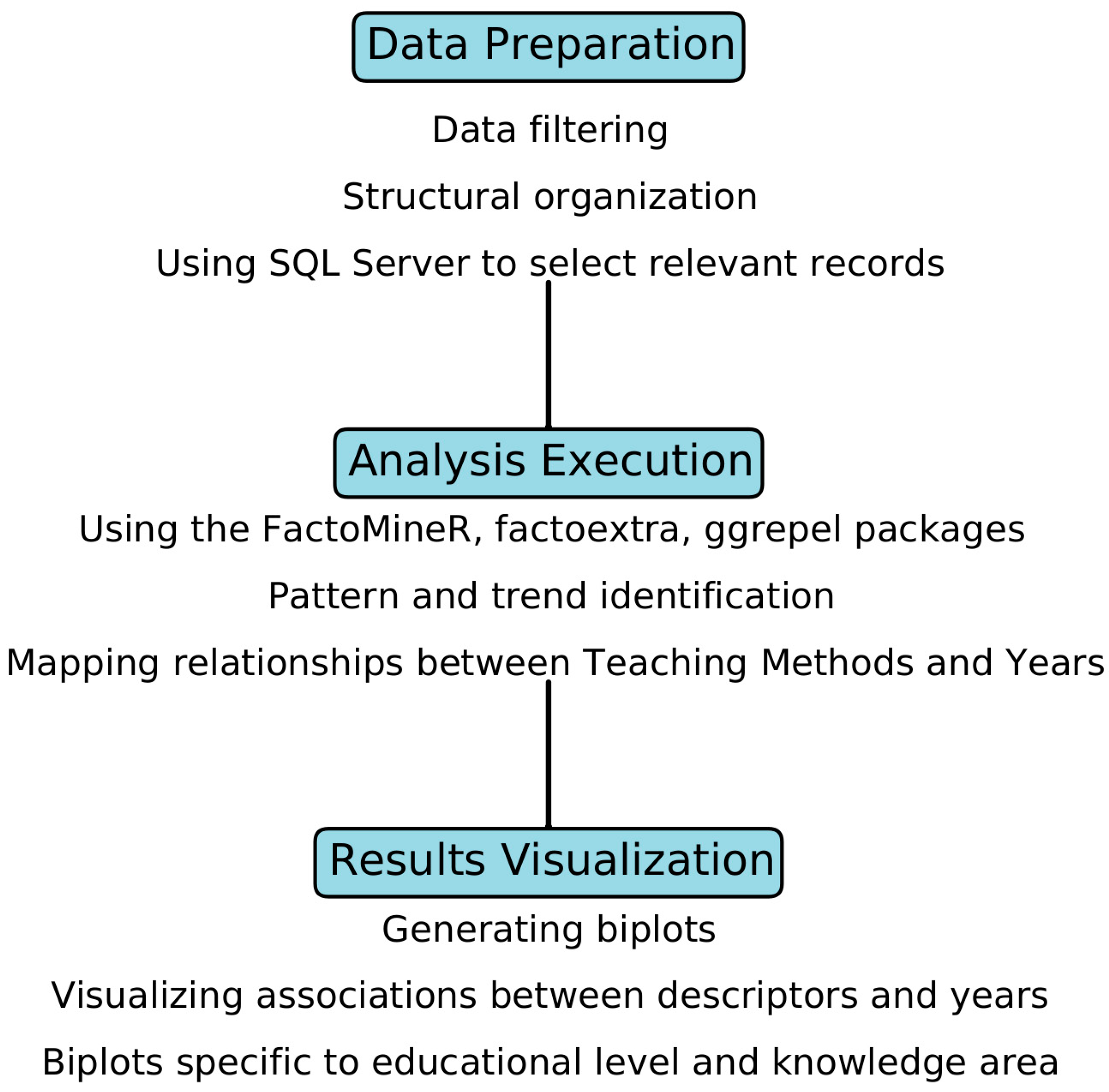
| Branch of Knowledge | Elementary | Secondary | Post-Secondary |
|---|---|---|---|
| Learning and Perception | 7580 | 7127 | 30,926 |
| Individual Development and Characteristics | 7627 | 7133 | 31,020 |
Disclaimer/Publisher’s Note: The statements, opinions and data contained in all publications are solely those of the individual author(s) and contributor(s) and not of MDPI and/or the editor(s). MDPI and/or the editor(s) disclaim responsibility for any injury to people or property resulting from any ideas, methods, instructions or products referred to in the content. |
© 2025 by the authors. Licensee MDPI, Basel, Switzerland. This article is an open access article distributed under the terms and conditions of the Creative Commons Attribution (CC BY) license (https://creativecommons.org/licenses/by/4.0/).
Share and Cite
Aguilar-Moya, R.; Diamanti, R.; Melero-Fuentes, D. Teaching Methods, Learning and Development: A 15-Year Research Perspective by Educational Stages. Educ. Sci. 2025, 15, 1213. https://doi.org/10.3390/educsci15091213
Aguilar-Moya R, Diamanti R, Melero-Fuentes D. Teaching Methods, Learning and Development: A 15-Year Research Perspective by Educational Stages. Education Sciences. 2025; 15(9):1213. https://doi.org/10.3390/educsci15091213
Chicago/Turabian StyleAguilar-Moya, Remedios, Roberta Diamanti, and David Melero-Fuentes. 2025. "Teaching Methods, Learning and Development: A 15-Year Research Perspective by Educational Stages" Education Sciences 15, no. 9: 1213. https://doi.org/10.3390/educsci15091213
APA StyleAguilar-Moya, R., Diamanti, R., & Melero-Fuentes, D. (2025). Teaching Methods, Learning and Development: A 15-Year Research Perspective by Educational Stages. Education Sciences, 15(9), 1213. https://doi.org/10.3390/educsci15091213







